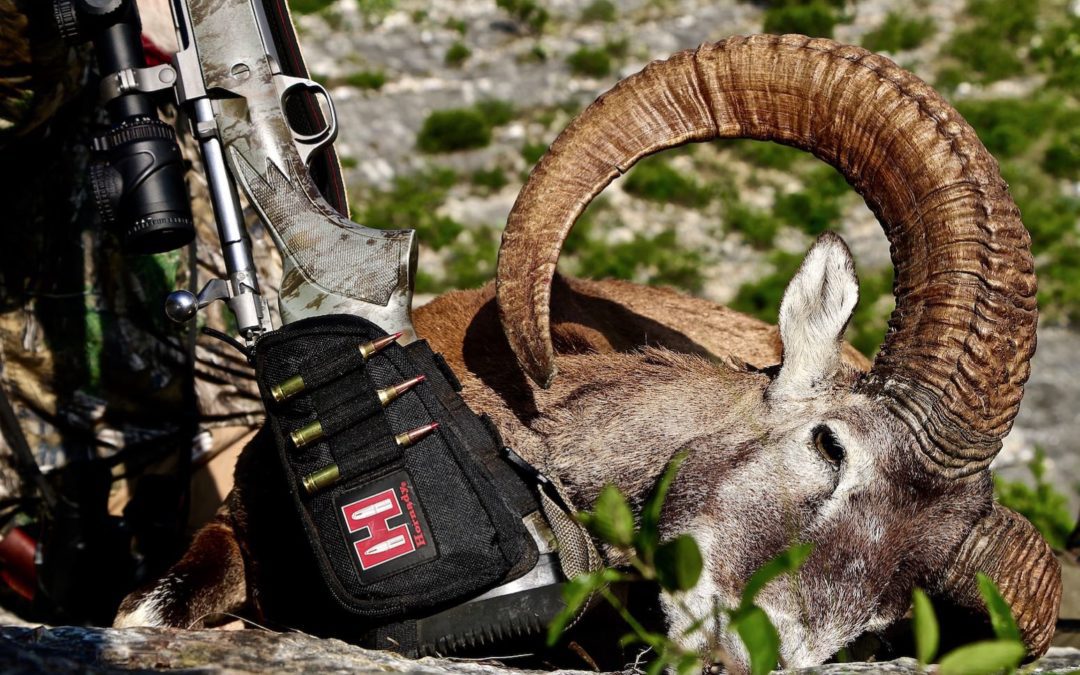“Adjust your elevation turret for 500 yards based on the range card we prepared for your rifle, scope and ammo combination.”
Before I could respond, Tim Fallon my hunting partner added, “What do you think the wind call should be?”
I cranked my Trijicon 2.5-12.5x scope’s elevation turret up 34 clicks, compensating for 31-inches of drop based on a 250-yard “zero,” shooting my Ruger M77 FTW Hunter .300 Win Mag using Hornady Precision Hunter 200-grain ELD-X loads.
“Think it’s a one-minute wind,” I said, “left to right based on the mirage, so about 5 inches of wind drift. I’ll hold just inside the left edge of the 14-inch plate.” I saw Tim nod approvingly.
Shooting prone, I pushed the Ruger’s safety to fire, totally exhaled, and held crosshairs allowing for wind drift. I gently squeezed the trigger and pinned it to the rear. Thanks to the rifle’s muzzle break I saw the bullet strike the plate about an inch to the left of dead center. “Do it again!” instructed Fallon. Moments later I hit the plate a second time about an inch low of dead center. A third shot hit the bull creating a less than 2-inch group.
Waiting for the barrel to cool and preparing for the 700-yard target, I reflected upon how things had changed when it comes to shooting and hunting. Years ago, shooting at targets at those longer distances in preparation for hunting season would not have happened. Back then I did not have the means to accurately assess true distances on long range targets. The rifle scope I used back then did not have external turrets to easily facilitate elevation adjustments. Long shots were primarily guess the distance and hold over. And even though my rifles had the accuracy potential for long distances, the available hunting ammo was not necessarily conducive to consistent long-range accuracy. Range finders, external adjustable turret scopes, and Hornady’s Precision Hunter ammo changed all that!
Before heading back to my Chevrolet pickup and camp, I put five shots into a 14-inch diameter steel plate at 700 yards – quite satisfying!
Back at camp Tim commented, “I know you are not an advocate of long range hunting. And you know, we here on the FTW Ranch are definitely not proponents of it either, other than under truly extenuating circumstances.
“However, I do think it’s important for hunters to learn to shoot long range, if for no other reason than to make them accurate and proficient at closer ranges. We stress it is the hunter’s responsibility to kill the animal with the first shot, not hope to simply hit it!
“If hunters can place their shots into the vitals, An area eight to 12 inches depending upon the species, and they practice shooting at 500 to 700 yards, then at 200 yards they should be able to precisely place the bullet in the vitals, putting the animal down quickly and humanely.”
“I love shooting long distance steel targets,” I replied. Getting to know my rifle, scope and ammo, along with my own capabilities. And even though I know I can hit a 14-inch steel plate at 1,000 yards, to me the challenge and fun of hunting is in getting as close to the animal as possible before squeezing the trigger, not shooting game at extremely long distances.”
A few days after shooting on the FTW Ranch’s S.A.A.M. (Sportsman All-Weather, All-Terrain Marksmanship ranges, I was crawling the OX Ranch’s rugged rocks attempting to get close to a majestic red sheep. After several days of hunting and great fun we found our desired mature ram. At a ranged 250 yards we ran out of stalking cover. There was no way to get closer. I got into prone position, cranked the Trijicon scope’s elevation turret up ten clicks to be dead-on at that distance, then settled in behind my Ruger. After having repeatedly hit 8-inch steel plate out to 700 yards, the 250-yard shot seemed like a chip shot.
I saw the bullet strike the ram and watched it pitch forward. I was thrilled! My time spent shooting at the range had paid off handsomely! Accurate shooting at long distance equals superb accuracy at closer ranges!

